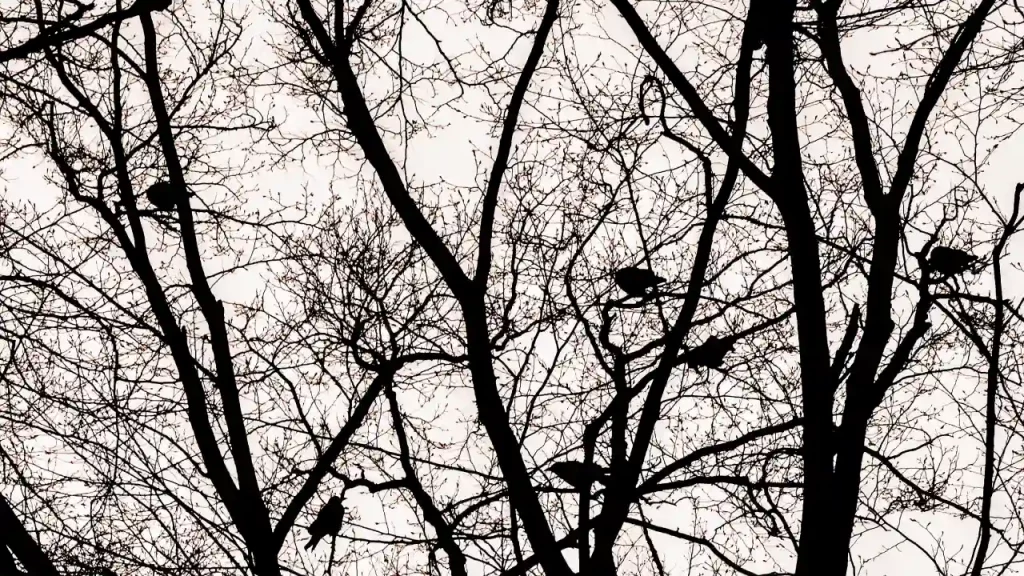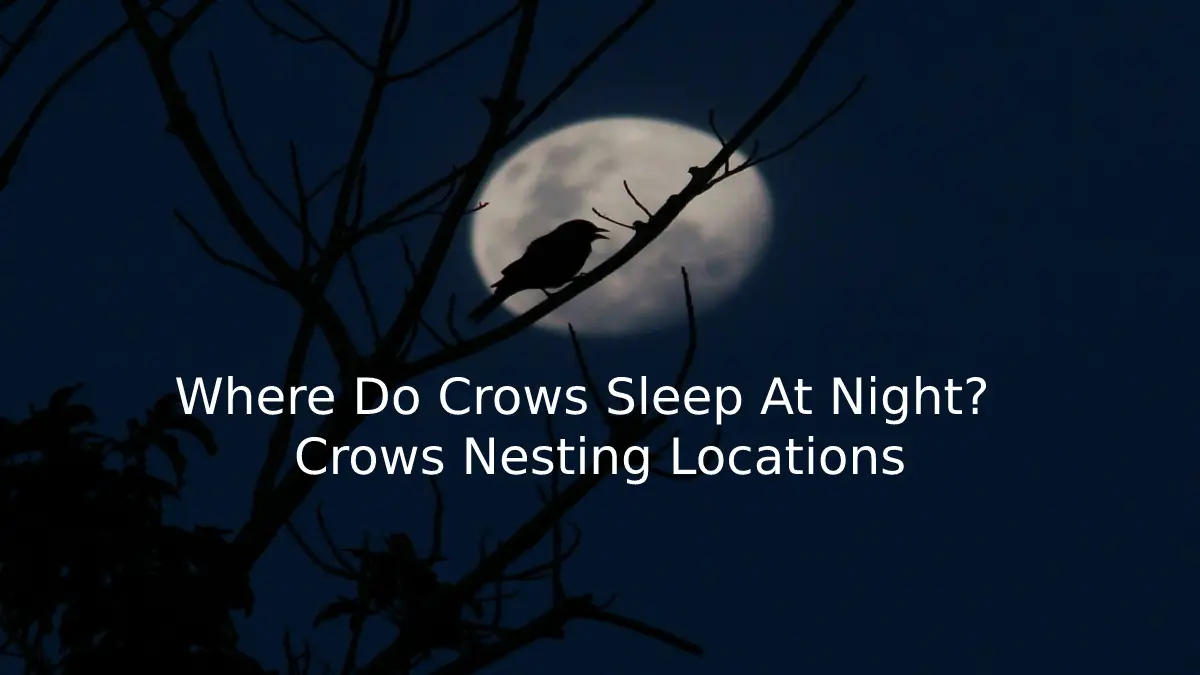At dusk, the horizon becomes dotted with hundreds of flitting black forms – crows, on their way to roost. Most of the year, the crow spends its night sleeping in a sprawling tree with the rest with a large group of its brethren.
Resting in trees as tall as 60-100 ft protects the flock and has helped preserve the crow’s safety at night for thousands of years, but there’s more to a crow’s sleeping arrangements than you might think.
Where Do Crows Sleep At Night?
The general location of a crow’s sleeping quarters is common sense; like most birds, crows sleep in trees. However, whether they sleep with a large flock or within their own territory depends on the time of year.
Crows separate their sleeping arrangements based on the mating season—younger birds not yet able to mate sleep in the same roost throughout the year.
Mating Season
During the mating season of spring (Late March through October), crows of mating age will leave the roost with their partner for individual territories.
After mating season, crows generally return to their original roost.
Non-Mating Season
During the non-mating season that takes place during November through late March, the crow resides in a tree with tall tree (usually around 50 ft or taller) with plenty of branches to host over a hundred birds. Some roosts hold as many as 10,000 birds.
Why Do Crows Roost In Trees? – Crows Sleeping Locations

The crow’s chosen sleeping quarters are a logical solution. There are several reasons why crows decide to dwell in large colonies among tall trees.
Safety In Numbers
Crows flock together for the same reason people do: safety in numbers. Roosting flocks can face off with most predators that come their way.
Additionally, sleeping in large groups deters many would-be predators from attempting to attack the flock.
Protection From Predators and The Elements
Tall trees make it hard for predators to attack crows. Additionally, the sturdy trees preferred by crows offer protection from the elements.
Crows can attach themselves with their talons to the strong tree limbs in even the strongest winds.
Strategic Location
A flock of crows can keep an eye out for threats, food, and essential environmental information from high up. Crows have the intelligence of a 7-year old child, which allows them to analyze patterns and note threats.
With such processing power, crows can remember the faces of humans who offer treats, common threats or frequent abusers, and even the trashcan schedule that may afford easy pickings for their scavenging. They often learn these patterns from their high-up roost.
How Do Crows Decide Where To Sleep?
Interestingly, a crow will fly as far as 50 miles from their roost in a day, only to return around dusk. But how do they decide where they’ll return to?
Like most analytical animals, crows do have some independent choice in selecting their sleeping quarters.
Location Benefits
Crows are scavengers, meaning they thrive in areas with plenty of garbage and plenty of prey.
Usually, this means crows select a tree near human habitation. The tree typically resides within a few miles of human habitation because younger crows don’t go too far from the roost.
Some flocks keep multiple pit-stop roosts between their usual scavenge area and the main roost. These stops allow crows to assemble into small groups as dusk draws near, providing more safety as they traverse home.
Location Risks
As previously mentioned, crows are unusually intelligent birds. Like elephants, they have remarkable memories.
As a result, they can teach their offspring potential or known threats and record attacks and dangers previously experienced.
When selecting a roost, crows will determine if the area has known threats nearby.
For example, if a particular human has a habit of shooting at crows, or if many dead bird carcasses fill an area, crows will generally avoid roosting nearby.
Other factors play a role in a flock’s selection of roost. For example, does the area have a nearby water source?
Is the tree large enough for their flock? Are there other flocks nearby that may attack? Crows have an instinct for finding the best home based on these factors.
Do Crows Sleep As Families?
As a species, crows are social and create bonds of solidarity within a flock. You can even find groups of up to 100,000 crows nesting together, parents and babies alike. However, unlike many birds, parents do not always nest with their offspring.
Generally, after the eggs hatch, parents will not sleep in the nest with their offspring. While the parents do provide food and shelter for their children, they usually roost a few branches away from their offspring alongside their mate.
The surrounding flock provides enough protection for parents to leave their children alone in the nest safely. There are exceptions to this rule.
In cold weather or in case of danger, parents usually nest with their offspring. Sometimes, crows will rest with their babies to show affection.
How To Ward Off Roosting Crows?
If a colony of crows has taken up residency in your favorite oak tree, scaring them off can pose a challenge.
Fake owls don’t fool crows easily; again, crows learn patterns and notice the artificial bird isn’t moving much. But if a flock needs relocating, there are ways to do so.
But first, understand there are rules regarding the removal of birds from their habitats.
Birds, including crows, are protected by the Migratory Bird Act of 1918. Under the act, it is illegal to harm their habitat, physically relocate their nests, or harm the birds, nests, or eggs. But can you have a pet raven?
So how does one try and get a bunch of crows to find another roost? Noise. Creating a loud disturbance when crows come home to roost will help deter them from sticking around.
Usually, avian experts recommend using recordings of bird distress calls to indicate a threat in the area.
Alternatively, a pot and pan clanging together work just fine. However, keep in mind that not all flocks respond to noise, and it works best with newer established roosts.
Goodnight, Crows!
When the sun sets, look to the skies. No doubt, a large flock of crows may dot the horizon, heading to a lovely big tree for some shut-eye.


